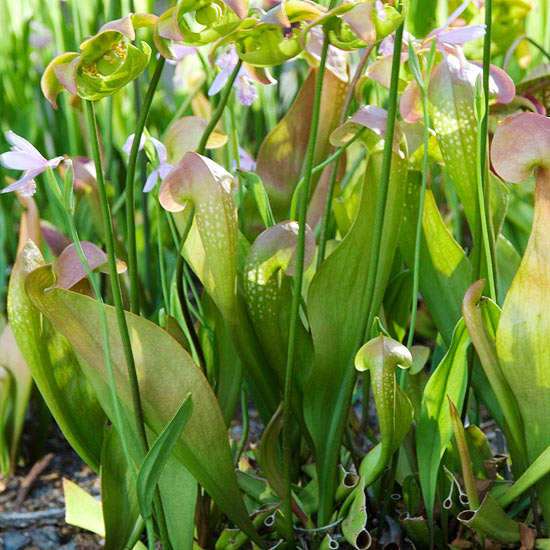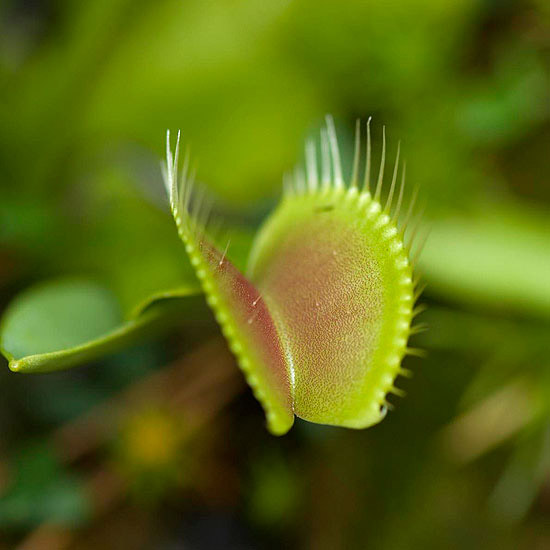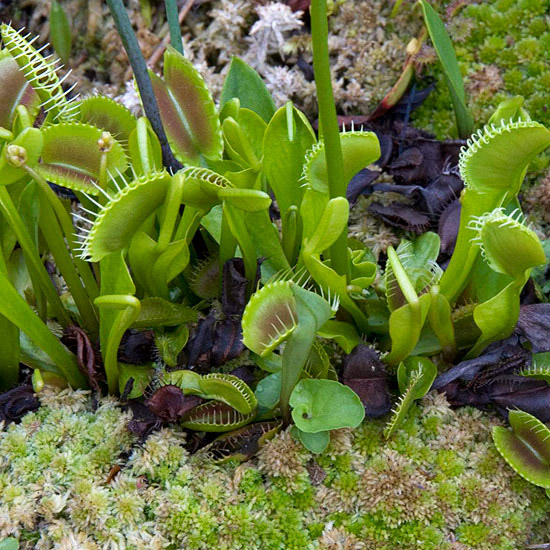






It may be hard to believe with their outlandish looks, but it can be easy growing carnivorous plants in your garden if you re-create the conditions where they grow in nature. The trick is usually to offer them bright (but not direct) sun, high humidity, and moist, acidic soil to grow in. If you're not able to create these conditions, it can be difficult to achieve success with carnivorous plants.
Before planting, check the hardiness of your selected plants; many that are natives of southern Zones may not survive winters in northern climates. But some, such as purple pitcher plant (Sarracenia purpurea) are hardy all the way to Zone 4.
Carnivorous plants do best in humid environments. If you live in a desert area, consider growing them in a closed environment, such as a terrarium, where you can control the humidity. Although carnivorous plants are natives of bogs, they don't want to grow in completely flooded conditions.
Let the rain water them, or else use purified water. Tap water from the spigot may contain too many additives for these plants. Because they come from specialized environments, they're more delicate than they look.
Protect most carnivorous plants from the heat of midday sunlight or they may burn. You can place tall bog plants, such as cattails, strategically so they shade carnivorous plants from the most intense light.
Carnivorous plants prefer acidic, well-drained soil, but keep in mind that they're from low-nutrient bogs. Most regular garden soils are too rich for them. Create your own bog by blending 1 part clean coarse sand to 2 parts sphagnum peat moss in a large container with drainage, such as a child's swimming pool with drainage holes punched in the bottom.

Like most other plants, carnivorous plants have green leaves packed with chlorophyll so they collect sunlight and use it to make energy for themselves. However, they've evolved to do best when their diet is supplemented with insects.
Carnivorous plants have come up with some ingenious means of catching prey. The classic Venus flytrap, for example, has pad-shape leaves with trigger hairs; the pads snap closed when an insect touches the hair. Pitcher plant has cup-shape leaves that fill with water. Slick hairs on the edges and insides of cups make insects slip inside and prevent them from climbing out. Sundews, meanwhile, cover themselves with sticky residue, so an insect becomes stuck to the plant upon landing, much like flypaper. All carnivorous plants have enzymes that digest the insects, allowing the plants to take in the nutrients.

Never collect carnivorous plants from the wild; many are on protected or endangered species lists. Check the source of your nursery's plants before you buy.
Pitcher plants (Sarracenia spp.) are native in many boggy areas of Eastern North America. Sarracenia purpurea, is the hardiest species and can be found as far north as Canada. Pitcher plants come in many shapes and sizes depending on the species -- and have different care requirements.
Sundew (Drosera spp.) leaves are covered with sticky red tentacles. Insects attracted by the sweet smell trigger the tentacles to close and the plant to digest the insect. Different sundew species are native to areas across the globe, from North and South America to Africa and Australia.
Venus flytraps (Dionaea muscipula) grow leaves shaped a bit like clamshells; they're ringed with tiny "teeth." When an insect lands on the center of the leaf, a hinge shuts, trapping its prey inside. It's native to areas of North and South Carolina.
Discover more about Venus flytraps.
Learn more about pitcher plants.
Check out other plants that like wet soil.
Copyright © www.100flowers.win Botanic Garden All Rights Reserved